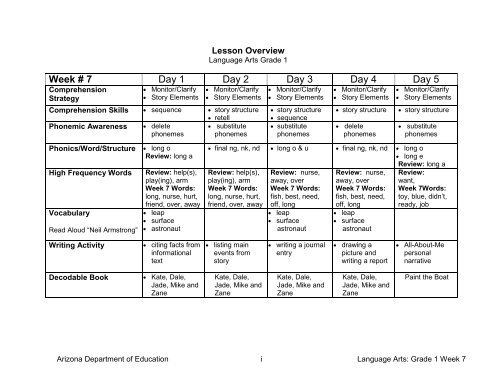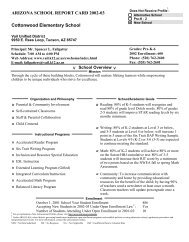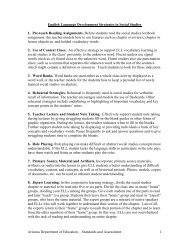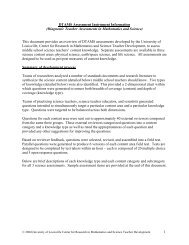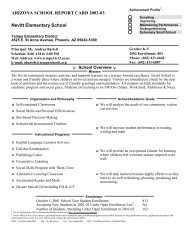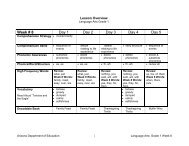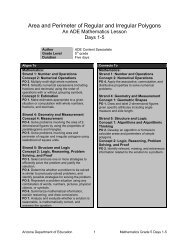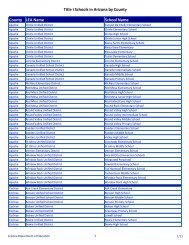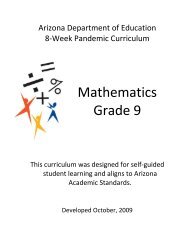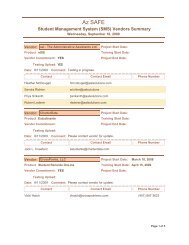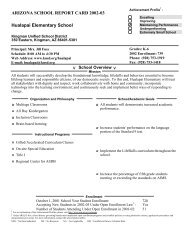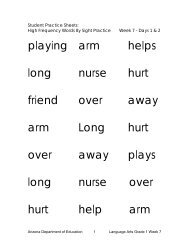1st grade weekly lesson plan - Arizona Department of Education
1st grade weekly lesson plan - Arizona Department of Education
1st grade weekly lesson plan - Arizona Department of Education
Create successful ePaper yourself
Turn your PDF publications into a flip-book with our unique Google optimized e-Paper software.
Lesson OverviewLanguage Arts Grade 1Week # 7 Day 1 Day 2 Day 3 Day 4 Day 5ComprehensionStrategy• Monitor/Clarify• Story Elements• Monitor/Clarify• Story ElementsComprehension Skills • sequence • story structure• retellPhonemic Awareness • delete• substitutephonemes phonemes• Monitor/Clarify• Story Elements• story structure• sequence• substitutephonemes• Monitor/Clarify• Story Elements• story structure• deletephonemes• Monitor/Clarify• Story Elements• story structure• substitutephonemesPhonics/Word/Structure • long oReview: long aHigh Frequency WordsVocabularyRead Aloud “Neil Armstrong”Review: help(s),play(ing), armWeek 7 Words:long, nurse, hurt,friend, over, away• leap• surface• astronaut• final ng, nk, nd • long o & u • final ng, nk, nd • long o• long eReview: help(s),play(ing), armWeek 7 Words:long, nurse, hurt,friend, over, awayReview: nurse,away, overWeek 7 Words:fish, best, need,<strong>of</strong>f, long• leap• surfaceastronautReview: nurse,away, overWeek 7 Words:fish, best, need,<strong>of</strong>f, long• leap• surfaceastronautReview: long aReview:want,Week 7Words:toy, blue, didn’t,ready, jobWriting Activity• citing facts frominformationaltext• listing mainevents fromstory• writing a journalentry• drawing apicture andwriting a report• All-About-MepersonalnarrativeDecodable Book• Kate, Dale,Jade, Mike andZaneKate, Dale,Jade, Mike andZaneKate, Dale,Jade, Mike andZaneKate, Dale,Jade, Mike andZanePaint the Boat<strong>Arizona</strong> <strong>Department</strong> <strong>of</strong> <strong>Education</strong> i Language Arts: Grade 1 Week 7
PO 2. Describe characters within a literaryselection, heard or read.PO 3. Sequence a series <strong>of</strong> events in aliterary selection, heard or read.Strand 3: Comprehending InformationalTextConcept 1: Expository TextPO 1. Identify the topic <strong>of</strong> expository text,heard or read.PO 2. Answer questions (e.g., who, what,where, when, why, how) about expositorytext, heard or read.WritingStrand 1: Writing ProcessConcept 1: Print ConceptsPO 1: Generate ideas through prewritingactivities (e.g., brainstorming)PO 2. Draw a picture or storyboard aboutideas generated.PO 3. Organize ideas using simple webs,maps, or lists.Concept 2: DraftingPO 1. Write a draft (e.g., story).Concept 3: RevisingPO 1. Reread original draft for clarity.PO 2. Add additional details with prompting.Concept 4: EditingPO 1. Review the draft for errors inconventions, with prompting.Concept 5: PublishingPO 1. Rewrite and illustrate selected pieces <strong>of</strong>writing for sharing with intended audience.PO 2. Write legibly.Strand 2: Writing ElementsConcept 1: Ideas and ContentPO 1. Write stand-alone text that expresses aclear message.PO 2. Incorporate details in pictures and text.Concept 2: OrganizationPO 1. Demonstrate sequencing or patterningin written test or story boards.PO 2. Show a sense <strong>of</strong> beginning.PO 3. Write multiple sentences in an orderthat supports a main idea or story.Concept 3: VoicePO 1. Create pictures and text that isexpressive, individualistic, engaging, andlively.<strong>Arizona</strong> <strong>Department</strong> <strong>of</strong> <strong>Education</strong> 2 Language Arts Grade 1 Week 7
Concept 4: Word ChoicePO 1. Use expressive or descriptive phrasesand short sentences, beyond one- or twowordlabels.Concept 5: Sentence FluencyPO 1. Write simple sentences.Concept 6: ConventionsPO 1. Incorporate conventions into own text,including:a) spacing between wordsd) placement <strong>of</strong> titlePO 2. Use capital letters correctly for thebeginning <strong>of</strong> a sentence.PO 3. Punctuate endings <strong>of</strong> sentences using:a. periodsb. question marksc. exclamation pointsStrand 3: Writing ApplicationsConcept 1: ExpressivePO 1. Write a narrative that includes:a. a main idea based on real or imaginedeventsb. charactersc. a sequence <strong>of</strong> eventConcept 2: ExpositoryPO 1. Create expository texts (e.g., journals)through drawing and/or writing.PO 2. Participate in creating simplesummaries from informational texts, graphs,tables, or maps.Concept 6: ResearchPO 1. Write a simple report with a title andthree facts, using information sources.Overview:This <strong>lesson</strong> focuses on building phonemic awareness, developing phonics skills, learningvocabulary that is found in the reading materials, and comprehending information in text.PurposeThese <strong>lesson</strong>s help students develop 4 different types <strong>of</strong> skills each week:• Phonemic awareness is the ability to hear, identify, and manipulate individual sounds(called phonemes) in spoken words. Before children learn to read, they need to becomeaware <strong>of</strong> how the sounds in words work. They must understand that words are made up<strong>of</strong> speech sounds, also called phonemes.• Phonics is the relationship between letters and sounds in a language. When childrenlearn that the letter B has the sound <strong>of</strong> /b/ or that "tion" sounds like /shun/, they arelearning phonics. Written language can be compared to a code, so knowing the sounds<strong>of</strong> letters and letter combinations will help children learn to read and spell.<strong>Arizona</strong> <strong>Department</strong> <strong>of</strong> <strong>Education</strong> 3 Language Arts Grade 1 Week 7
• Vocabulary is the knowledge <strong>of</strong> words and word meanings in both print and orallanguage. Learning new words and their meanings is important for understanding whatis read or heard.• Comprehension is the process <strong>of</strong> understanding spoken language or text. It is not onlyimportant for children to be able to sound out and pronounce words, but they should alsounderstand the meaning <strong>of</strong> the words they read.Materials• Grade 1 Routines handout• Alphabet chart• Student Practice Sheetso High Frequency Words By Sight Practice Sheetso Decodable stories Kate, Dale, Jade, Mike, and Zane, Paint the Boato Read aloud passage Neil Armstrongo Comprehension Activitieso Writing Activities• Vocabulary words• Notebook paper or note cards• Pencil, pens and/or markers• Optional Computer access http://www/org/Curriculum/pdf/GK-1/Archive/V_Final.pdfObjectivesStudents will:• Delete and substitute phonemes (sounds) to make new words.• Read and write words with long a, long e, long o, long u, and ng, nk, nd endings.• Read regular and irregular high frequency words including: helps, playing, arm, long,nurse, hurt, friend, over, away, fish, best, need, <strong>of</strong>f, long, want, toy, blue, didn’t, ready,job.• Understand the following vocabulary words in context: leap, surface, astronaut.• Restate facts from listening to a read aloud text and responding to questions about thetext.• Answer simple questions using who, what, when, where, and why in completesentences.• List facts from an informational article.• List main events from a decodable text.• Retell a story from decodable text.• Write a journal entry.• Write a report, using listed facts from informational article.• Draw an engaging picture to accompany the report.• Write a personal narrative.Lesson ComponentsPrerequisite Skills: The student should know how to write a sentence, including starting with acapital letter and ending with punctuation marks.<strong>Arizona</strong> <strong>Department</strong> <strong>of</strong> <strong>Education</strong> 4 Language Arts Grade 1 Week 7
DAY 1PHONEMIC AWARENESSSay the following:• Listen carefully to the following instructions.• We are going to delete the first sound <strong>of</strong> the word I say.• I will do the first one, tram.• I’m going to delete the /tr/.• The new word is am.• Here’s another word, throw.• I’m going to delete the /th/.• The new word is row.Use the words below for student practice.Word Take Away (Delete) New Wordhit /h/ itchat /ch/ atman /m/ ansat /s/ atchair /ch/ airPHONICSHigh Frequency Words by SightHigh Frequency Words are words that students will commonly see in what they read and inconversations they hear. Because these words are so common, students should learn thesewords so they can automatically read them and not have to sound them out each time. The list<strong>of</strong> high frequency words may have repeated words or contain a change <strong>of</strong> case (capitalized orlower case) for multiple opportunities to practice.• See the Grade 1 Routines handout (High Frequency Words by Sight) for instructions.• Practice the high frequency words using the Student Practice Sheets-High FrequencyWords by Sight Practice – Week 7 – Days 1 & 2.Phonics/Word Structure: Focus letters/sounds: long oThe focus <strong>of</strong> this <strong>lesson</strong> is to learn to read words with the long o sound. These words have theletter combinations <strong>of</strong> o_e as found in the words vote, smoke, and note. Write the words listedbelow on a piece <strong>of</strong> paper.note wrote lone robe stole vote• See the Grade 1 Routines handout (Phonics/Word Structure) for instructions.<strong>Arizona</strong> <strong>Department</strong> <strong>of</strong> <strong>Education</strong> 5 Language Arts Grade 1 Week 7
VOCABULARYUse the Grade 1 Routines handout (Vocabulary Word Instruction) to review and practice thefollowing words.• leap (verb) to jump high into the air, or to jump to land in a different place• surface (noun) the top layer <strong>of</strong> land or water• astronaut (noun) someone who travels to spaceCOMPREHENSIONUse the text from the read aloud Neil Armstrong to help students work on the skills <strong>of</strong>understanding what they hear. (Student Practice Sheets–Read Aloud – Week 7- Days 1 & 4)Read Aloud: Neil Armstrong• See the Grade 1 Routines handout (Read Aloud) for instructions.Say: The text you just heard gave us a lot <strong>of</strong> information about the moon landing. Write downsome <strong>of</strong> the facts you remember on Student Practice Sheet – Comprehension Activity – Week7- Day 1.You may reread the story or parts <strong>of</strong> it to enable the child to pick out relevant facts. Monitor andassist the child with spelling, spacing, capitalization, and punctuation. Save the fact page forDay 4.DAY 2PHONEMIC AWARENESSSay the following• Listen carefully to the following instructions.• We are going to replace a sound in a word to make a new word. I will do the first one.• The next word is came.• Take away the /m/ and replace it with a /k/ and the word is cake.• Here’s another word, tale.• Take away the /l/ and replace it with /k/ and the word is take.Use the words below for student practice.Word Substitute (replace) New Wordcute /m/ for the /k/ mutebarn /ur/ for the /ar/ burntight /f/ for the /t/ fightmeet /oa/ for the /ee/ moatman /e/ for the /a/ mentoe /j/ for the/t/ Joe<strong>Arizona</strong> <strong>Department</strong> <strong>of</strong> <strong>Education</strong> 7 Language Arts Grade 1 Week 7
PHONICSHigh Frequency Words by SightHigh Frequency Words are words that students will commonly see in what they read and inconversations they hear. Because these words are so common, students should learn thesewords so they can automatically read them and not have to sound them out each time. The list<strong>of</strong> high frequency words may have repeated words or contain a change <strong>of</strong> case (capitalized orlower case) for multiple opportunities to practice.• See the Grade 1 Routines handout (High Frequency Words by Sight) for instructions.• Practice the high frequency words using the Student Practice Sheets-High FrequencyWords by Sight Practice – Week 7 – Days 1 & 2.Phonics Word Structure: Focus letters/sounds: Final ng, nk, ndThe focus <strong>of</strong> this <strong>lesson</strong> is to learn to read words with final ng, nk, and nd. These words havethe letter combinations as found in the words hang, mink, and band. Write the words listedbelow on a piece <strong>of</strong> paper.land ring sink think sting swing mink frank mind• See the Grade 1 Routines handout (Phonics/Word Structure) for instructions.FLUENCYPhrase Reading PracticePhrase reading practice helps students practice reading phrases (or groups <strong>of</strong> words) andstories at a speed that is similar to natural speech.• Write the groups <strong>of</strong> words or phrases listed below on a piece <strong>of</strong> paper.tells her momskates at the rinkclose to the lakeswings by the lakewith a fluteat the lakewaves with both arms• See the Grade 1 Routines handout (Phrase Reading Practice) for instructions.Decodable Reading Practice• See the Grade 1 Routines handout (Decodable Reading Practice) for instructions.• Student will read Kate, Dale, Jade, Mike, and Zane using the Student Practice Sheets –Decodable Story - Week 7 - Days 1, 2, 3 & 4.• When the student reads, the words should flow and sound natural like spoken language.• The student should re-read the story aloud at least twice.<strong>Arizona</strong> <strong>Department</strong> <strong>of</strong> <strong>Education</strong> 8 Language Arts Grade 1 Week 7
COMPREHENSIONStory RetellSay: Many children and adults like to keep a diary or journal <strong>of</strong> their special days, trips, andvacations. n a journal, the writer tells about his day and what he may be thinking or feeling.Sometimes the author will include photos or draw pictures in the journal.Say: You will be writing a journal entry about the children’s day at camp. Let’s think for amoment about what happened today in the story. (Ask the student to share some <strong>of</strong> the events.Encourage the student to look back in the story. Help the student brainstorm if necessary.)Say: Write down your ideas (use the Student Practice Sheets – Comprehension: Retell - Week7 – Day 2).When the student finishes, read through the list together. Assist the student with spelling,spacing, capitalization and punctuation. Ask if anything needs to be added to the list orchanged. Edit together.Save the list for Day 3.DAY 3PHONEMIC AWARENESSSay the following• Listen carefully to the following instructions.• We are going to substitute a sound in the middle <strong>of</strong> a word.• I will do the first one, fake.• Take away the /k/ and replace it with a /m/ and the word is fame.• The next word is fame.• Take away the /m/ and replace it with /s/ and the word is face.Use the words below for student practice.Word Substitute New Wordlime /k/ for the /m/ likebest /ch/ for the /b/ chestkit /a/ for the /i/ cat<strong>plan</strong> /ai/ for the /a/ plaintoast /ai/ for the /oa/ tastePHONICSHigh Frequency Words by SightHigh Frequency Words are words that students will commonly see in what they read and inconversations they hear. Because these words are so common, students should learn thesewords so they can automatically read them and not have to sound them out each time. The list<strong>of</strong> high frequency words may have repeated words or contain a change <strong>of</strong> case (capitalized orlower case) for multiple opportunities to practice.• See the Grade 1 Routines handout (High Frequency Words by Sight) for instructions.• Practice the high frequency words using the Student Practice Sheets-High FrequencyWords by Sight Practice – Week 7 – Days 3 & 4.<strong>Arizona</strong> <strong>Department</strong> <strong>of</strong> <strong>Education</strong> 9 Language Arts Grade 1 Week 7
Phonics Word Structure: Focus letters/sounds: long u (u_e)The focus <strong>of</strong> this <strong>lesson</strong> is to learn to read words with long u (u_e). These words have the lettercombinations as found in the words tune, blue, and dude. Write the words listed below on apiece <strong>of</strong> paper.rude rule tune June dune• See the Grade 1 Routines handout (Phonics/Word Structure) for instructions.FLUENCYDecodable Reading Practice• See the Grade 1 Routines handout (Decodable Reading Practice) for instructions.• Student will read Kate, Dale, Jade, Mike, and Zane using the Student Practice Sheets –Decodable Story - Week 7- Days 1, 2, 3, & 4.• When the student reads, the words should flow and sound natural like spoken language.• The student should re-read the story aloud at least twice.COMPREHENSIONResponse to Literature: Retell-Journal ActivityThe student will use the events written on Student Practice Sheets – Comprehension: Retell -Week 7 – Day 2 to complete the journal entry. (Student Practice Sheets – Comprehension:Journal Activity - Week 7 – Day 3)Say: Today you are going to complete a journal page about the events in the story Kate, Dale,Jade, Mike, and Zane. Use your notes from yesterday to help you complete the activity. Writethe events in complete sentences.Assist the student with spelling, spacing, capitalization and punctuation. The student shouldread the journal entry out loud. Ask if anything needs to be added to the entry or changed. Edittogether.VOCABULARYUse the Grade 1 Routines handout (Vocabulary Word Instruction) to review and practice thefollowing words.• leap (verb) to jump high into the air, or to jump to land in a different place• surface (noun) the top layer <strong>of</strong> land or water• astronaut (noun) someone who travels to space<strong>Arizona</strong> <strong>Department</strong> <strong>of</strong> <strong>Education</strong> 10 Language Arts Grade 1 Week 7
DAY 4PHONEMIC AWARENESSSay the following:• Listen carefully to the following instructions.• We are going to take away sounds at the beginning <strong>of</strong> words.• I will do the first word, stop.• Take away the /s/ sound and the word is top.• The next word is pants.• Take away the /p/ sound and the word is ants.• The next word is think.• Take away the /th/.• What is the new word? (ink)Use the words below for student practice.Word: Delete (Take Away) New Wordblow /b/ lowbring /b/ ringstare /st/ airsash /s/ ashflake /f/ lakePHONICSHigh Frequency Words by SightHigh Frequency Words are words that students will commonly see in what they read and inconversations they hear. Because these words are so common, students should learn thesewords so they can automatically read them and not have to sound them out each time. The list<strong>of</strong> high frequency words may have repeated words or contain a change <strong>of</strong> case (capitalized orlower case) for multiple opportunities to practice.• See the Grade 1 Routines handout (High Frequency Words by Sight) for instructions.• Practice the high frequency words using the Student Practice Sheets-High FrequencyWords by Sight Practice – Week 7 – Days 3 & 4.Phonics/Word Structure: Focus letters and sounds: Final nd, nk, ngSee the Grade 1 Routines handout (Phonics/Word Structure) for instructions.The focus <strong>of</strong> this <strong>lesson</strong> is to learn to read words that have the letter combinations Final nd, nk,ng. Write the words listed below on a piece <strong>of</strong> paper.land think sting swing mink mind blink stinkband sand sing thing bring send bank ring<strong>Arizona</strong> <strong>Department</strong> <strong>of</strong> <strong>Education</strong> 11 Language Arts Grade 1 Week 7
FLUENCYDecodable Reading Practice• See the Grade 1 Routines handout (Decodable Reading Practice) for instructions.• Student will read Kate, Dale, Jade, Mike, and Zane using the Student Practice Sheets –Decodable Story - Week 7- Days 1, 2, 3, & 4.• When the student reads, the words should flow and sound natural like spoken language.• The student should re-read the story aloud at least twice.VOCABULARYUse the Grade 1 Routines handout (Vocabulary Word Instruction) to review and practice thefollowing words.• leap (verb) to jump high into the air, or to jump to land in a different place• surface (noun) the top layer <strong>of</strong> land or water• astronaut (noun) someone who travels to spaceCOMPREHENSIONUse the text from the read aloud Neil Armstrong to help students work on the skills <strong>of</strong>understanding what they hear. (Student Practice Sheets–Read Aloud – Week 7- Days 1 & 4)Read Aloud: Neil Armstrong• See the Grade 1 Routines handout (Read Aloud) for instructions.Say: On Day 1, you listened to the story and wrote a list <strong>of</strong> facts. (Student Practice Sheet –Comprehension Activity – Week 7- Day 1) Draw a picture about the moon landing. Then use thefacts to write a paragraph about Neil Armstrong and the Apollo Mission. (Student Practice Sheet– Comprehension Activity: Paragraph – Week 7- Day 4)You may need to help the student with sentence starters like: This astronaut…, He…, I wish…,Space travel…, The Apollo astronauts…, or They…Monitor and assist the child with spelling, spacing, capitalization, and punctuation. Ask thestudent to read the paragraph aloud and edit if necessary.DAY 5PHONEMIC AWARENESSSay the following:• Listen carefully to the following instructions.• We are going to substitute sounds at the beginning, middle, or end <strong>of</strong> the word.• The first word is came.• Take away the /m/ and replace it with a /k/.• What is the new word? (cake)<strong>Arizona</strong> <strong>Department</strong> <strong>of</strong> <strong>Education</strong> 12 Language Arts Grade 1 Week 7
• Who are the characters in this story? (Dad and Ray)• Where do you think the story take place? Why? (The story probably takes place outsidebecause they are painting and then floating the boat.)• What was the problem in the story? (Dad spilled the paint on Ray’s feet.)• What happened at the end <strong>of</strong> the story? (Ray floats his boat.)WRITINGWriting an All-About-Me StorySay:• We just finished reading a story about Ray and his dad. It was a story about somethingthat happened the day that Ray and his dad painted a toy boat. Today you are going towrite a special story. It is going to be all about you! The first step will be to <strong>plan</strong> yourstory. Fill in the boxes with some writing ideas. You will list some story ideas thathappened to you. (Student Practice Sheets – Writing: Ideas – Week 7- Day 5)• Choose a story idea from one <strong>of</strong> the boxes. It should be an idea with a lot <strong>of</strong> details.• Tell me your story.Encourage the student to add details. Ask questions to clarify what happened.Say: Our next step is to write the story. (Student Practice Sheets – Writing: All-About-Me RoughDraft– Week 7- Day 5) Start with a “grabber”. You want to get your readers’ attention.Something like, Smash! Crash! Bang! The fireworks were screaming at me. (The story would beabout a 4 th <strong>of</strong> July celebration.) Another example: My brother was really lucky to live through mylast birthday party.Help the student think <strong>of</strong> a “grabber” for their story.Say: Write the main idea (grabber) on your paper. Then finish the story with at least four greatdetails.Give the student time to write. Help with brainstorming and writing.Say:• The next step is to revise the story. First we will read the story out loud then make anychanges that are necessary. You may need to add something you forgot or changesome <strong>of</strong> your words.• Now take a moment to check over your rough draft. Check your sentences for spelling,spacing, capitalization, and punctuation.• The final step is to publish your story. Write a neat final copy. (Student Practice Sheets –Writing: All-About-Me Final Copy – Week 7- Day 5)<strong>Arizona</strong> <strong>Department</strong> <strong>of</strong> <strong>Education</strong> 14 Language Arts Grade 1 Week 7
AssessmentStudents should be able to read the decodable story Kate, Dale, Jade, Mike, and Zane at theend <strong>of</strong> Day 4 with fewer than 20 errors.ExtensionsGo to the website at http://www/fcrr.org/Curriculum/pdf/GK-1/Archive/V_Final.pdf• Select one <strong>of</strong> the activities to complete.SourcesBeck, I.L., McKeown, M. G., & Kucan, L. (2002) Bringing Words to Life: Robust VocabularyInstruction. Guilford. New York.Carnine, D., Silbert, J., Kame’enui, E.J. (1990) Direct Reading Instruction. Second Edition.Prentice Hall. Columbus Ohio.<strong>Arizona</strong> <strong>Department</strong> <strong>of</strong> <strong>Education</strong> 15 Language Arts Grade 1 Week 7


